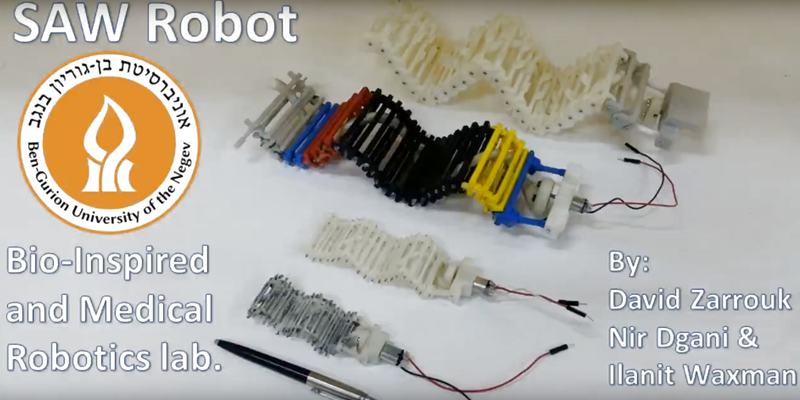With more and more research in the field of autonomous robotics, new methods of locomotion are coming on the scene at a rapid pace. Forget wheels and tracks, forget bi-, quad-, hexa- and octopods, and forget fancy rolling BB-8 clones. If you want to get a mini robot moving, maybe you should teach it to do the worm.
Neither the Gizmodo article nor the abstract of [David Zarrouk]’s paper gives too many details on the construction of this vermiform robot, but there are some clues to be gleaned from the video below. At the 1:41 mark we see the secret of the design – a long corkscrew in the center of the 3D-printed linkages.
Driven by a single motor, the linkages translate the screwing motion into an undulating wave, propelling the robot either forward or backward. Steering is provided by a non-driven tiller wheel up front; we could see a two-screw version of this robot using parallel tracks to provide directional control. [Zarrouk] et al have adapted the basic design in other ways, too – one waterproof version swims like an eel, and one tiny bot is the size of a pen. The latter has the potential for further miniaturization, with the aim of building autonomous endorobots for therapeutic applications. Neat stuff.
Thanks for the tip, [Itay]

















Brilliant!
Why do the waves appear to move in the opposite direction of travel?
Is there something else going on with the linkage that provides forward motion? I would have thought that the waves would appear to be stationary while the robot moves forwards, not the other way around.
I’m thinking it’s the same as a sidewinder moving across sand, they kinda look like they are moving the “wrong” way
https://www.youtube.com/watch?v=B3NbPUTD5qA
https://www.youtube.com/watch?v=TMxK24wGyH8
I’m thinking more an optical illusion – you see the different coloured segments moving but if you can concentrate on the “wave” rather than the parts it does what you suggest. At 45 Sec when it’s going up the wall I think the effect is more noticeable.
Don’t think about the wave motion, think of how a single segment moves. Compare it to a foot – first the heel hits the ground, then it rolls forward onto the toes, then it lifts up. That obviously is correct for forward movement, and you can see that the “low point” is also moving forward.
That russian army all terain truck is better design, less parts, same principle. https://youtu.be/RbDe5dEu07I?t=38s
I partially agree, the russian truck could consist of less mechanical parts and is therefore a “better” design.
Because (in my point of view) the beauty of a design lies in the number of parts used to create a certain function.
But the russian army truck uses the screw motion. Where the mechanism of the SAW robot uses the wave principle. These are fundamentally different regarding the way they make contact with the ground or medium they are moving on/through. Let me explain:
The plastic parts of the SAW robot only move up and down and therefore it can move forward/backwards using only 1 set of SAW mechanism (sorry, I do not know how exactly how to cal it).
If the russian truck would consist of only one screw, it would simply try to rotate around its horizontal axis.
Now a device that moves only forward and backwards isn’t really practical, most of the times you want to go left and right, so you’d need a second screw or SAW mechanism. In case of the mechanisms, the SAW mechanism would be dirty only at the bottom halve, while the screw would be dirty all around. Which isn’t a big problem for the screws. So if I would to choose a principle… I’d go for the screw. But I like the idea of the SAW robot.
they are both corkscrews, the saw adds extra parts between the corkscrew and the terrain, which can be advantageous since the designer can choose or control the material properties (friction coefficient) between the corkscrew and the oscilliating wave segments (if dirt can be prevented to enter the mechanism, like the waterproof eel version), while the designers of the dual screw car can not choose the friction coefficient of the terrain.
Also this saw design allows for a wider contact patch with the ground, more evenly distributing it’s weight. My understanding is the screw trucks are used is swamps and bogs, where the buoyancy of their hollow screws keeps them from sinking into the mud and the screw cuts into the muck, creating good traction. I bet a version of this saw mechanism, maybe with paddles or ridges along its length, would perform very well in the same mucky environments while maintaining the ability to drive on surfaces that would damage a screw type, like asphalt or concrete.
I really like this but not sure why; ‘outside of the box’ design possibly.
It looks extremely fragile but seems to handle every obstacle example well.
Looking forward to seeing a larger future version.
awesome
Have a look at http://spectrum.ieee.org/automaton/robotics/robotics-hardware/singleactuator-wave-robot-zip-around-with-high-speed-wiggles
You will find more details
But can it do the Helicopter?
No, but I think it can do the Locomotion.
If you’re going to use 1 motor for drive and another to steer wheels…why not just use two SAW drive mechanisms and steer like a tank.
Am i the only one who noticed the water test, looks like they covered the robot in an very flexible and sturdy material (Condom) :-)
Very clever!
It reminds of a single photon propagation.